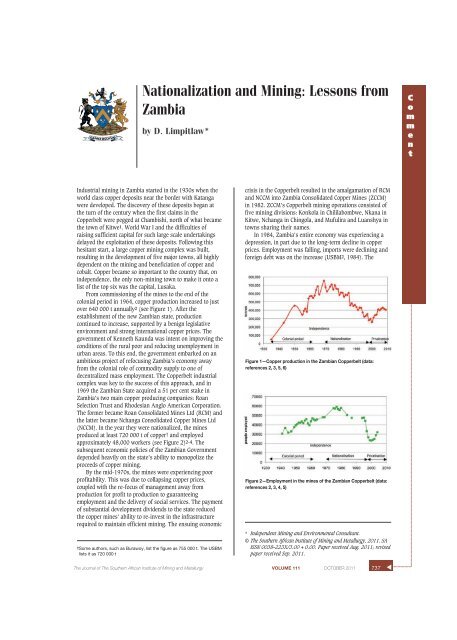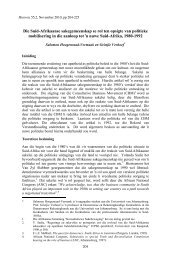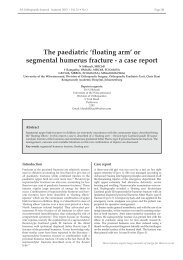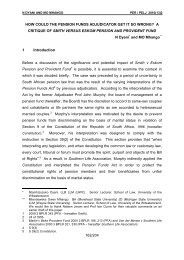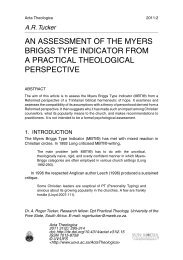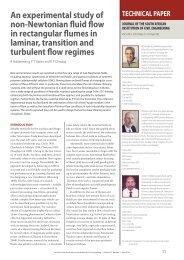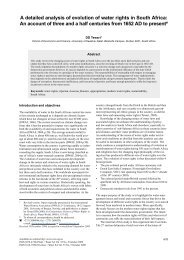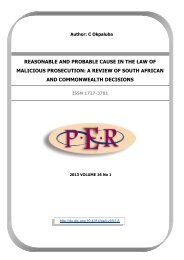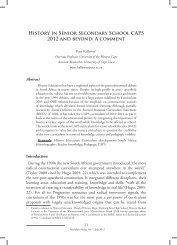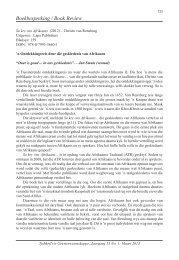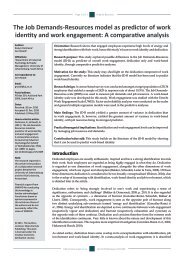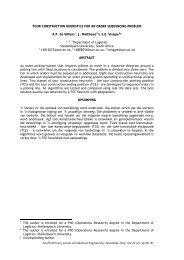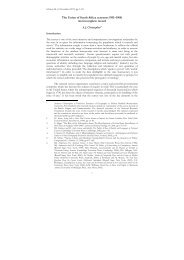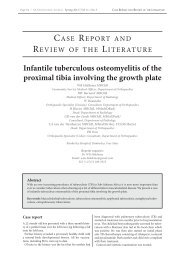Nationalization and Mining: Lessons from Zambia
Nationalization and Mining: Lessons from Zambia
Nationalization and Mining: Lessons from Zambia
Create successful ePaper yourself
Turn your PDF publications into a flip-book with our unique Google optimized e-Paper software.
<strong>Nationalization</strong> <strong>and</strong> <strong>Mining</strong>: <strong>Lessons</strong> <strong>from</strong><br />
<strong>Zambia</strong><br />
by D. Limpitlaw*<br />
C<br />
o<br />
m<br />
m<br />
e<br />
n<br />
t<br />
Industrial mining in <strong>Zambia</strong> started in the 1930s when the<br />
world class copper deposits near the border with Katanga<br />
were developed. The discovery of these deposits began at<br />
the turn of the century when the first claims in the<br />
Copperbelt were pegged at Chambishi, north of what became<br />
the town of Kitwe1. World War I <strong>and</strong> the difficulties of<br />
raising sufficient capital for such large scale undertakings<br />
delayed the exploitation of these deposits. Following this<br />
hesitant start, a large copper mining complex was built,<br />
resulting in the development of five major towns, all highly<br />
dependent on the mining <strong>and</strong> beneficiation of copper <strong>and</strong><br />
cobalt. Copper became so important to the country that, on<br />
independence, the only non-mining town to make it onto a<br />
list of the top six was the capital, Lusaka.<br />
From commissioning of the mines to the end of the<br />
colonial period in 1964, copper production increased to just<br />
over 640 000 t annually2 (see Figure 1). After the<br />
establishment of the new <strong>Zambia</strong>n state, production<br />
continued to increase, supported by a benign legislative<br />
environment <strong>and</strong> strong international copper prices. The<br />
government of Kenneth Kaunda was intent on improving the<br />
conditions of the rural poor <strong>and</strong> reducing unemployment in<br />
urban areas. To this end, the government embarked on an<br />
ambitious project of refocusing <strong>Zambia</strong>’s economy away<br />
<strong>from</strong> the colonial role of commodity supply to one of<br />
decentralized mass employment. The Copperbelt industrial<br />
complex was key to the success of this approach, <strong>and</strong> in<br />
1969 the <strong>Zambia</strong>n State acquired a 51 per cent stake in<br />
<strong>Zambia</strong>’s two main copper producing companies: Roan<br />
Selection Trust <strong>and</strong> Rhodesian Anglo American Corporation.<br />
The former became Roan Consolidated Mines Ltd (RCM) <strong>and</strong><br />
the latter became Nchanga Consolidated Copper Mines Ltd<br />
(NCCM). In the year they were nationalized, the mines<br />
produced at least 720 000 t of copper† <strong>and</strong> employed<br />
approximately 48,000 workers (see Figure 2)2–4. The<br />
subsequent economic policies of the <strong>Zambia</strong>n Government<br />
depended heavily on the state’s ability to monopolize the<br />
proceeds of copper mining.<br />
By the mid-1970s, the mines were experiencing poor<br />
profitability. This was due to collapsing copper prices,<br />
coupled with the re-focus of management away <strong>from</strong><br />
production for profit to production to guaranteeing<br />
employment <strong>and</strong> the delivery of social services. The payment<br />
of substantial development dividends to the state reduced<br />
the copper mines’ ability to re-invest in the infrastructure<br />
required to maintain efficient mining. The ensuing economic<br />
†Some authors, such as Burawoy, list the figure as 755 000 t. The USBM<br />
lists it as 720 000 t<br />
crisis in the Copperbelt resulted in the amalgamation of RCM<br />
<strong>and</strong> NCCM into <strong>Zambia</strong> Consolidated Copper Mines (ZCCM)<br />
in 1982. ZCCM’s Copperbelt mining operations consisted of<br />
five mining divisions: Konkola in Chililabombwe, Nkana in<br />
Kitwe, Nchanga in Chingola, <strong>and</strong> Mufulira <strong>and</strong> Luanshya in<br />
towns sharing their names.<br />
In 1984, <strong>Zambia</strong>’s entire economy was experiencing a<br />
depression, in part due to the long-term decline in copper<br />
prices. Employment was falling, imports were declining <strong>and</strong><br />
foreign debt was on the increase (USBM2, 1984). The<br />
Figure 1—Copper production in the <strong>Zambia</strong>n Copperbelt (data:<br />
references 2, 3, 5, 6)<br />
Figure 2—Employment in the mines of the <strong>Zambia</strong>n Copperbelt (data:<br />
references 2, 3, 4, 5)<br />
* Independent <strong>Mining</strong> <strong>and</strong> Environmental Consultant.<br />
© The Southern African Institute of <strong>Mining</strong> <strong>and</strong> Metallurgy, 2011. SA<br />
ISSN 0038–223X/3.00 + 0.00. Paper received Aug. 2011; revised<br />
paper received Sep. 2011.<br />
The Journal of The Southern African Institute of <strong>Mining</strong> <strong>and</strong> Metallurgy VOLUME 111 OCTOBER 2011<br />
737<br />
▲
<strong>Nationalization</strong> <strong>and</strong> <strong>Mining</strong>: <strong>Lessons</strong> <strong>from</strong> <strong>Zambia</strong><br />
budget deficit increased to US$150 million. Foreign debt of<br />
$2.6 billion had to be restructured. By 1986 a noticeable<br />
decline in copper production resulted in the closure of many<br />
mining units <strong>and</strong> led to the implementation of a five-year<br />
plan to revive the company8. This was not successful, <strong>and</strong> by<br />
the end of the 1980s the Nkana Division, capable of<br />
producing 5 Mt of copper ore per annum, was only producing<br />
2 Mt. Similarly, Mufulira was producing 1.8 Mt instead of<br />
2.5 Mt8.<br />
By 1987 <strong>Zambia</strong> had to agree to harsh economic<br />
measures in order to access financial assistance <strong>from</strong> the<br />
IMF. These included cuts in the civil service, loosening<br />
control of interest rates <strong>and</strong> the elimination of price subsidies<br />
(USBM2, 1987). The price of food increased to the point<br />
where riots broke out in Kitwe. <strong>Zambia</strong> broke off negotiations<br />
with the World Bank which then cancelled aid to the country.<br />
The Kwacha collapsed <strong>and</strong> <strong>Zambia</strong>’s external debt ballooned<br />
to $ 5.8 billion. At one point, <strong>Zambia</strong> was paying 95% of its<br />
foreign exchange earnings to service debt.<br />
In the early 1990s, the government announced its<br />
intention to sell at least 49% of its share in all parastatals,<br />
including ZCCM (USBM2, 1991). By this stage heavy foreign<br />
debt was crippling the economy.<br />
Throughout much of its history, ZCCM lacked the capital<br />
to upgrade its operations, <strong>and</strong> by the end of the 1990s, when<br />
most operating units were privatized, little exploration had<br />
been carried out for 25 years. Shortages of spare parts <strong>and</strong><br />
over-use of old equipment affected production. In addition,<br />
ZCCM failed to modernize <strong>and</strong> continued the colonial practice<br />
of providing virtually all services within some of the mining<br />
towns. In Kalulushi, for example, the parastatal was<br />
responsible for water reticulation, waste removal, health care,<br />
security, <strong>and</strong> other municipal services. ZCCM had become a<br />
state within a state.<br />
One of the primary arguments advanced for state<br />
ownership of the Copperbelt mines was the provision of<br />
secure employment. The graph in Figure 2 shows that this<br />
was a failure. The state miner, ZCCM, managed to neither<br />
safeguard jobs nor the value of those jobs. In the 1990s, a<br />
mine employee told me that he had bought a new plastic<br />
bucket to water his garden in Chingola. When he realized that<br />
he was paid the equivalent of less than 50 plastic buckets per<br />
month, he left his job at ZCCM.<br />
The process of privatization was finally started in 1996<br />
after a few failed attempts. The first round of bidding went<br />
badly <strong>and</strong> the operations, considered by <strong>Zambia</strong>ns to be the<br />
jewels in the crown, were not scooped up. Anglo American<br />
was one of the few diversified mining heavyweights<br />
interested in operating the old ZCCM mines. Anglo struggled<br />
to find a joint venture partner but eventually brought Codelco<br />
of Chile, ironically a state-run miner, on board. Before the<br />
deal was concluded, Codelco pulled out due to political<br />
considerations in Chile, <strong>and</strong> Anglo was left without a major<br />
partner. The state of disrepair of the mines <strong>and</strong> short-term<br />
fluctuations in the copper price further reduced the<br />
profitability of the Anglo’s newly acquired operations, the<br />
proceeds <strong>from</strong> which were supposed to keep the existing<br />
mines afloat while the new Konkola Deeps mining project<br />
was developed. The upshot was the disinvestment of Anglo<br />
<strong>from</strong> the Copperbelt within a short time.<br />
Currently, the Government of <strong>Zambia</strong> retains a minority<br />
interest in most of the large projects <strong>and</strong> mines through its<br />
holding company <strong>Zambia</strong> Consolidated Copper Mines<br />
Investment Holdings plc (ZCCM-IH).<br />
Turning decrepit mining infrastructure around is very<br />
difficult. Even with the privatization programme, poverty in<br />
<strong>Zambia</strong> deepened in the 1990s. In 1991, 70 per cent of the<br />
population was estimated to live below the poverty line9. This<br />
had increased to 73 per cent by 199810 <strong>and</strong> was exacerbated<br />
by the privatization <strong>and</strong> retrenchments that occurred towards<br />
the end of that decade. In 1998 the Mine Worker’s Union of<br />
<strong>Zambia</strong> (MUZ) estimated that it had 37 000 members<br />
compared to 60 000 in 19789. By the end of 1999, privatization<br />
resulted in a total of 8 329 employees being<br />
retrenched, leading to the disruption of nearly 42 000<br />
livelihoods if a figure of five dependants per employee is<br />
assumed.<br />
<strong>Zambia</strong>’s experience has lessons for South Africa. Once a<br />
mine asset is run down, it is very expensive, difficult, <strong>and</strong><br />
time-consuming to get it into efficient production again.<br />
These are not factories that can be turned off <strong>and</strong> on again.<br />
Unserviced machinery falls apart <strong>and</strong> becomes useless,<br />
workings collapse, <strong>and</strong> shafts flood, skilled managers <strong>and</strong><br />
operators get jobs elsewhere, <strong>and</strong> the task of re-starting<br />
becomes exponentially more difficult with the passage of<br />
time. In <strong>Zambia</strong> the contribution of mining to GDP fell <strong>from</strong><br />
32.9 per cent in 1973 to about 7.7 per cent in 2003, a decline<br />
of nearly 77 per cent11 even after the privatization of ZCCM<br />
was largely complete. From the start of the privatization<br />
process until 2004, US$1.4 billion was invested in the mining<br />
sector11. Even this large amount only managed to restore<br />
copper production to 400 000 t in 2004, just over half of the<br />
historical peak tonnage. In 2009, <strong>Zambia</strong>n copper production<br />
amounted to 405 000 t (USGS7, 2009).<br />
<strong>Mining</strong> is a high risk, capital intensive industry that<br />
requires access to large numbers of highly skilled people,<br />
most of whom are motivated by personal gain. There are very<br />
few examples of efficiently run state-owned mines that make<br />
a positive contribution to their country’s economy, the copper<br />
operations of Chile’s Codelco being the exception. Chile’s<br />
success in running nationalized mines is in no small part due<br />
to the fact that Chilean mining schools have historically<br />
produced more than double South Africa’s number of mining<br />
engineering graduates. These Spanish-speaking engineers<br />
are also less mobile than South African graduates in the<br />
English language dominated world of mining.<br />
Removal of the risk/reward profit motive will accelerate<br />
the current flight of skills to other mining locations—already<br />
the Australians pay a substantial premium over local salaries<br />
for mining engineers. This will leave South Africa unskilled,<br />
uncompetitive, <strong>and</strong> begging for international buyers for the<br />
now rundown mines, with nothing but ruined assets to sell.<br />
As <strong>Zambia</strong> has shown, one decade is not enough time to<br />
recover <strong>from</strong> confusing the role of the State with that of<br />
private capital. If nationalization is the only way to lift the<br />
majority of the country’s people out of poverty <strong>and</strong><br />
deprivation, then South Africa had better commit substantially<br />
more resources to producing mining professionals:<br />
engineers, metallurgists, <strong>and</strong> geologists as well as operators,<br />
to run these state owned enterprises, because the people<br />
currently employed will soon be enticed away by overseas<br />
competitors.<br />
▲<br />
738 OCTOBER 2011 VOLUME 111 The Journal of The Southern African Institute of <strong>Mining</strong> <strong>and</strong> Metallurgy
<strong>Nationalization</strong> <strong>and</strong> <strong>Mining</strong>: <strong>Lessons</strong> <strong>from</strong> <strong>Zambia</strong><br />
References<br />
1. MENDELSOHN, F. The Geology of the Northern Rhodesian<br />
Copperbelt.MacDonald, London, UK, 1961. 523 pp.<br />
2. US BUREAU OF MINES. Minerals Year Books, 1964–1991.<br />
http://uwdc.library.wisc.edu/collections/EcoNatRes. Accessed 20 Jun<br />
2011.<br />
3. HYWEL D. D. <strong>Zambia</strong> in Maps. University of London Press, London, UK.<br />
1971.<br />
4. BURAWOY, M. The colour of class on the copper mines. African<br />
Advancement in to <strong>Zambia</strong>nization. African Social Research, <strong>Zambia</strong>n<br />
Papers, no. 7. Van Velsen, J. <strong>and</strong> Henderson, I. (eds.). Institute for African<br />
Studies, University of <strong>Zambia</strong>, Lusaka, <strong>Zambia</strong>, 1972. 121 pp.<br />
5. NORTHERN RHODESIA CHAMBER OF MINES. Year Books 1956–1963. Kitwe,<br />
Northern Rhodesia.<br />
6. MACFARLANE, A. Managing mineral wealth—the contribution of the mining<br />
<strong>and</strong> minerals sector to the economic development of southern Africa.<br />
<strong>Mining</strong>, Minerals <strong>and</strong> Sustainable Development Southern Africa. Research<br />
topic no.5: <strong>Mining</strong>, minerals <strong>and</strong> economic development: the transition to<br />
sustainable development in southern Africa. Johannesburg, South Africa,<br />
2001. 127 pp.<br />
7. US GEOLOGICAL SURVEY. Minerals Year Books 1997–2009. The Mineral<br />
Industry of <strong>Zambia</strong>. http://minerals.usgs.gov/minerals/pubs/country.<br />
Accessed 6 Jun 2011.<br />
8. KWANGA, S. A case study on the privatization of <strong>Zambia</strong> Consolidated<br />
Copper Mines. <strong>Mining</strong>, Minerals <strong>and</strong> Sustainable Development Southern<br />
Africa. Research topic no.5: <strong>Mining</strong>, minerals <strong>and</strong> economic development:<br />
the transition to sustainable development in southern Africa.<br />
Johannesburg, South Africa, 2001. 29 pp.<br />
9. HANSUNGULE, M., FEENEY, P., <strong>and</strong> PALMER, R. Report on l<strong>and</strong> tenure<br />
insecurity on the <strong>Zambia</strong>n Copperbelt. Oxfam GB, <strong>Zambia</strong>. 90 pp.<br />
10. CIVIL SOCIETY FOR POVERTY REDUCTION. Poverty reduction strategy paper for<br />
<strong>Zambia</strong>. http://www.sarpn.org.za. Accessed 20 Oct. 2002.<br />
11. GOVERNMENT OF ZAMBIA. The Fifth National Development Plan: 2006–2011.<br />
Chapter 15: <strong>Mining</strong>. Lusaka, <strong>Zambia</strong>, 2005. 51 pp.. ◆<br />
C<br />
o<br />
m<br />
m<br />
e<br />
n<br />
t


